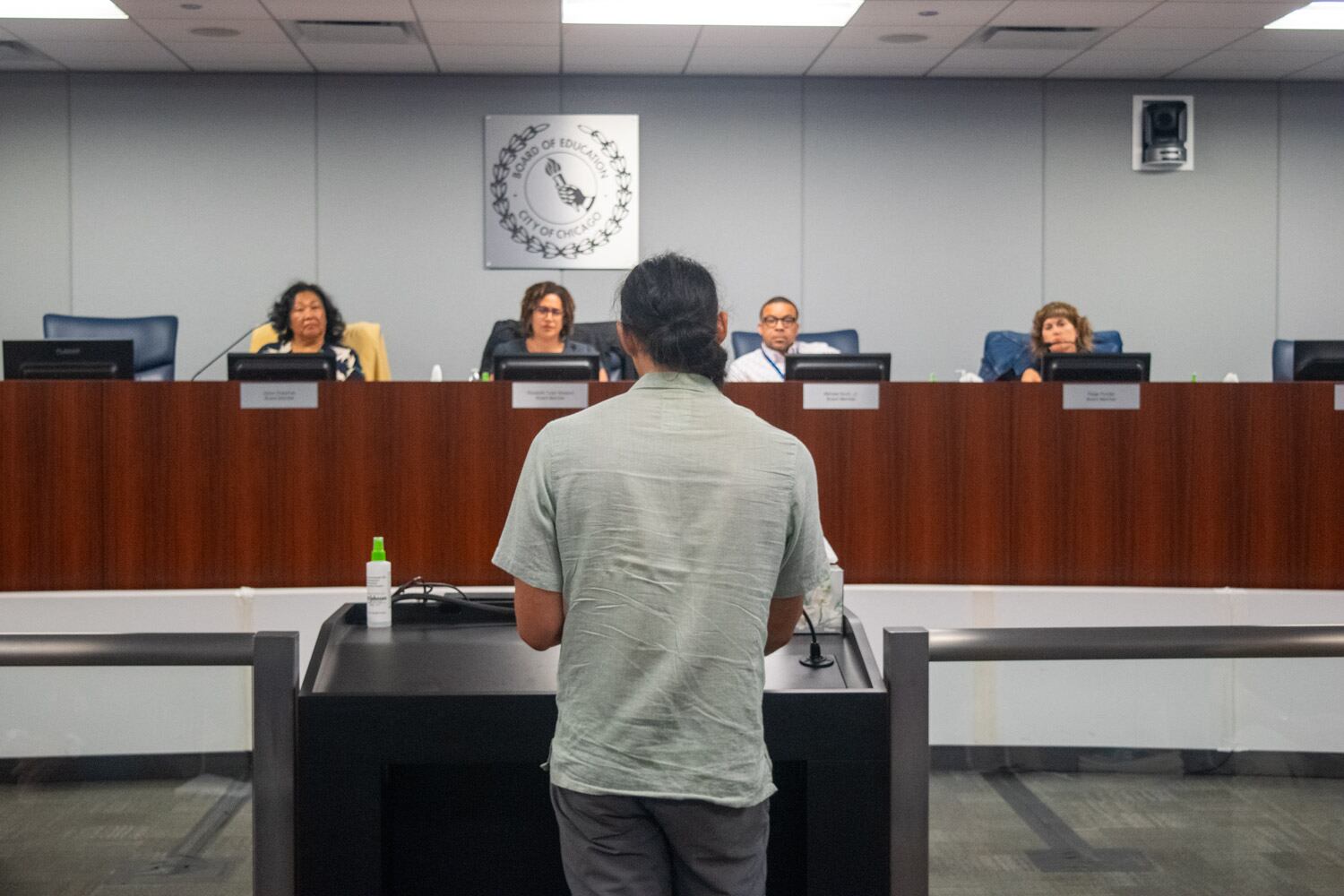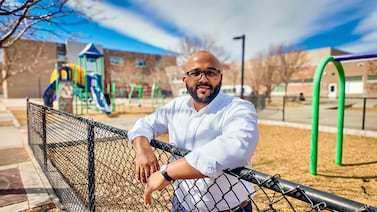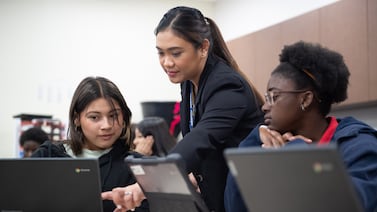Sign up for Chalkbeat Chicago’s free daily newsletter to keep up with the latest education news
The upheaval engulfing Chicago Public Schools didn’t start when Mayor Brandon Johnson prodded schools CEO Pedro Martinez to step down last month. Or when the entire school board resigned at once. Or when Johnson swiftly appointed new members “tasked to carry out the vision that I have for public education in this city.”
And the disagreements roiling the school system just weeks before voters choose the first members of a new elected board aren’t just about whether the city should take out a short-term, high-interest loan to cover pension payments.
In many ways, the conflict can be traced back to pivotal decisions made five years ago. The district agreed to an ambitious new teachers union contract after a bruising 2019 strike that followed years of struggles to balance the budget. The Chicago Teachers Union successfully made the case that more staff earning higher salaries would help students in schools that lacked the resources to meet their needs.
But even then, leaders were unsure how they would pay for all the new staff positions and salary increases over the life of the contract. Federal pandemic aid came to the district’s rescue, allowing Chicago Public Schools to cover the contract, hire more staff, and make investments that many educators and community members felt were long overdue.
Now that money is going away, leaving the district with a math problem it hasn’t yet decided how to solve.
Districts around the country are facing difficult choices about which programs to keep and whether to lay off employees, but Johnson has said he’s not interested in making cuts. And he has a narrowing window in which to push through a loan that would temporarily avoid cuts or find another solution.
This is playing out in a city where decades of fraught education politics have eroded trust. Chicago provides a stark example of the challenges many districts are facing with the expiration of federal COVID relief money, declining enrollment, and larger payrolls. How Chicago resolves the crisis could mean cuts to staff and programming now or taking on debt that could impact how much money is available for future generations.
“Right now all the key players are attacking one another and looking for the immediate battles to fight and win,” said Kenneth Wong, professor of education policy at Brown University. “But the core of this debate is about whether Chicago Public Schools are going to be better off as a result of these decisions and is the city going to benefit from a higher-quality Chicago Public Schools as a result of these decisions.”
Chicago school budget problems built for years
Struggling to pay for things is not new for Chicago Public Schools. In the 1990s, then-CEO Paul Vallas deferred pension payments to balance an anticipated $1.4 billion budget deficit.
The district also took out a series of emergency loans to deal with budget shortfalls between 2016 and 2018. According to the district, it still owes $2.1 billion on those loans, including $200 million this year alone.
Chicago Public Schools won a partial reprieve to its school funding struggles in 2017 when the state of Illinois revamped its funding formula to send more money to districts with higher needs. State funding makes up a quarter of the district’s operating budget.
But if the state continues with its current rate of annual increases, it won’t fully fund the formula until at least 2034, according to a report from the Center for Tax and Budget Accountability.
Five years ago, as the Chicago Teachers Union fought for a wide-ranging contract that led to an 11-day strike, it was unclear how the city or district would pay for all of the demands. At the time, union president Stacy Davis Gates accused then Mayor Lori Lightfoot’s administration of not kicking in enough city money to properly fund the district.
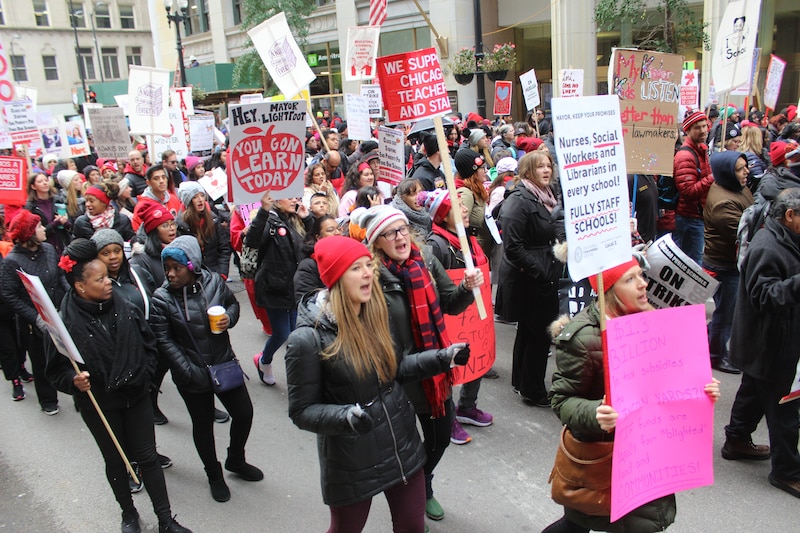
While the deal fell short of some of the union’s biggest goals, it required the district to hire more staff, including social workers and nurses, raise salaries, and commit to lowering class sizes. In total, the contract was expected to cost $1.5 billion over its five-year lifetime.
Two credit rating agencies called the costs “manageable,” but Standard and Poor’s issued a warning: The district’s expenses could outpace how much money it actually had on hand, and that could degrade the district’s already junk bond rating status.
Five months after the contract was finalized, COVID-19 hit.
At a recent press conference, Gates acknowledged the $2.8 billion the district received in federal pandemic relief was critical to paying for the 2019 contract, which she credits with helping bring academic gains.
“We received that money from [federal COVID relief] funds because the Chicago Public Schools has never been funded at the rate in which it needed to be funded, ever,” she said.
Federal COVID relief funding helped pay for the teachers union contract, launch new academic recovery programs, and sustain current programs that otherwise may have been pared down or cut. In the spring of last school year, a Chalkbeat analysis of spending found an average 7% of Chicago’s school budgets were made up of COVID dollars.
CPS doubled the number of social workers and added hundreds more interventionists who work with students struggling in core subjects. The money also went toward a slew of other initiatives, including limiting class sizes and growing its universal preschool program. It helped the district paper over longstanding deficits that have plagued its budget for many years.
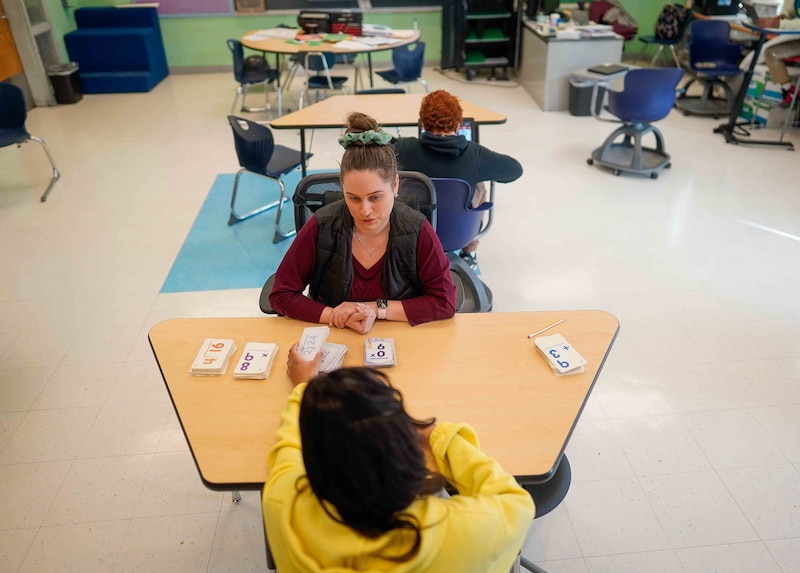
Between 2019 and this fall, the district said it has hired more than 6,500 additional staffers, including 2,600 teachers and 4,000 paraprofessionals. Today, the district’s budget is roughly $10 billion – a nearly 30% increase in five years — even as the district is serving fewer students.
Paul Bruno, assistant professor of educational policy, leadership, and organization at University of Illinois Urbana-Champaign, said Chicago is not alone. Districts around the country have added staff for reasons that need more research. Employing more people makes it harder to raise pay, and with more spots to fill, districts can struggle to hire only the best candidates or fill all their positions. Bruno said it’s not clear that it’s always in the best interests of students.
School leaders previously told Chalkbeat that the extra money helped their schools provide more after-school programs to children and beef up academic support in ways they never had the flexibility to do.
“Winning the lottery is what it felt like,” one former school administrator said. “Everything your kid ever asked for, you could give them.”
The federal dollars dried up last month, and the loss of that money helped create a more than half-billion-dollar deficit for CPS. The district closed that budget gap through central office cuts and other savings, but it did not budget for big costs coming its way in the next union contract or in pension obligations. District and city officials pressed the state for more funds, but state leaders refused.
At a recent City Council hearing, Martinez acknowledged that he’s been criticized for spending one-time money on long-term personnel expenses. Knowing that federal COVID money would expire, some districts invested in facilities or hired people on short-term contracts, while others followed Chicago’s approach of hiring more permanent staff.
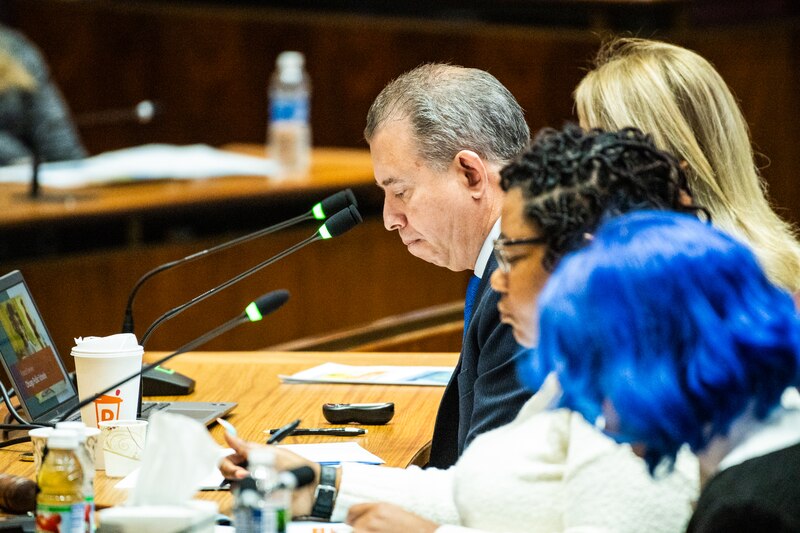
Martinez argued that the additional investments helped the district see “gains we have not seen before, and we are seeing more of our students graduating with a real shot of having economic mobility.”
Chicago’s reading scores recovered faster than many other large urban school districts, according to one study from Harvard and Stanford that the district has cited frequently while making its case for more funding.
Johnson committed to avoiding cuts
Now the district and the teachers union are at the bargaining table again, with the union pushing for 9% raises for teachers, along with “common good” proposals such as affordable housing for homeless students. The district says paying for just a portion of the union’s wide-ranging proposals would create a $4 billion deficit by the 2029-30 school year. CPS has already offered 4% raises, but the two parties are now in mediation.
Another looming cost is pensions for non-teaching staff. Former Mayor Lightfoot shifted a portion of pension costs onto the district in 2020, a practice Mayor Johnson has tried to continue. But so far this year, the district has refused to pay a $175 million contribution to the municipal pension fund, putting the city on the hook as it faces its own deficit.
To cover the cost of pensions and the union contracts, Johnson’s office has pushed CPS to take out a short-term loan. The district has refused, citing concerns that such a loan would come with high interest rates and saddle CPS with more debt down the road. Martinez asked the mayor to dedicate more funds from special taxing districts, known as TIFs, to cover the pension cost.
At stake is how much money the district will have to invest in classrooms and salaries now versus in the future. The disagreement could yet cost Martinez his job.
Johnson’s presence in the mayor’s office looms large over the negotiations. Johnson is a former classroom teacher and union organizer who got his start in politics working to oppose school closures. On the campaign trail, Johnson called for fully funded schools. In an interview earlier this month with WBEZ, he was adamant that CPS should not make cuts — as most other districts in Chicago’s position are planning.
“Guess who loses when we cut schools?” he said. “Black and brown children. I don’t want Black and brown children to lose under my administration. In fact, they’re not going to lose under my administration.”
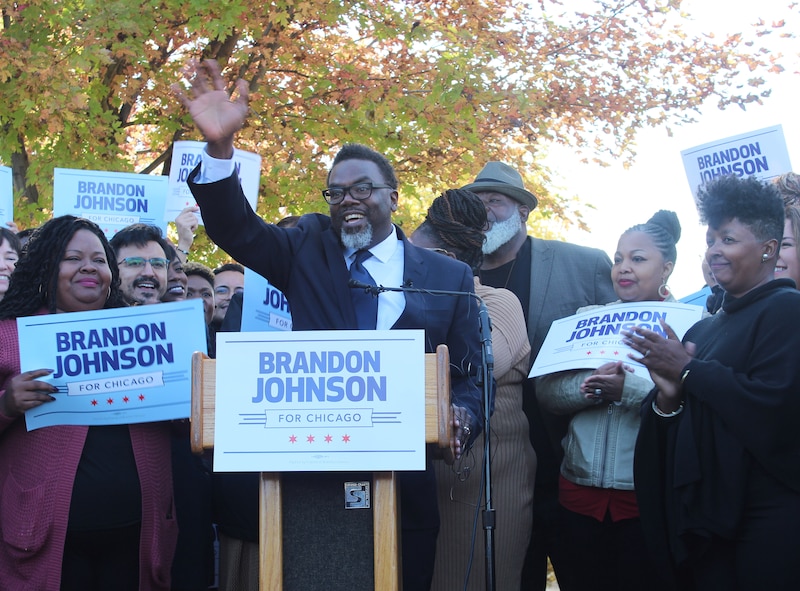
“The new mayor is probably closer to the unions than any mayor in history and he’s committed to raising salaries substantially,” said Thomas Toch, director of Future Ed, an education think tank at Georgetown University that focuses on underserved students.
Spending more on teachers helps students most when districts spend on better-performing teachers and those in hard-to-fill subjects, Toch said, strategies teachers unions generally oppose. At the same time, Chicago stands out among large, urban districts for its investments in high-impact tutoring and the academic gains students have made in recent years.
If Chicago makes major cuts now, “there is a significant risk of losing that positive momentum,” Toch said.
Sally Nuamah, a professor at Northwestern University who has studied Chicago Public Schools, said Johnson faces a decision: “Will he be the progressive, activist mayor that he ran on being? Or will he acquiesce?”
Nuamah noted that the dispute in Chicago doesn’t seem to be about whether to cut but how to find additional money.
If Chicago can find a way to fund these investments into the future, other districts would pay attention, Nuamah said. But historically, taking on debt for ongoing costs has been dangerous for school systems.
It will now be up to the new and future board members to untangle the district’s financial issues.
For the first time in Chicago’s history, voters will choose 10 elected school board members on Nov. 5. The school board will expand to a total of 21 members, with the remaining 11 chosen by the mayor. The board will become fully elected in 2027.
Related: Everything you need to know about Chicago’s 2024 school board election
Voters could choose school board members aligned with the mayor’s vision or elect people more inclined to push back.
Before the election, Johnnson’s new appointees could fire Martinez. Asked whether it plans to do that, school board president the Rev. Mitchell Ikenna Johnson declined to answer, calling it “a silly question.”
The prospect of leadership change could be driving some of the turmoil, said Bruno, the University of Illinois professor.
“There’s an urgency from the city’s perspective to make as many policy decisions as possible before the power dynamics change,” he said. “Johnson wants to impose more of his own agenda and that sense of urgency might be exacerbating things.”
Reema Amin is a reporter covering Chicago Public Schools. Contact Reema at ramin@chalkbeat.org.
Erica Meltzer is Chalkbeat’s national editor based in Colorado. Contact Erica at emeltzer@chalkbeat.org.

